How Does the Control of Grain Purchase Price Affect the Sustainability of the National Grain Industry? One Empirical Study from China
Abstract
1. Introduction
2. Materials and Methods
2.1. Data Sources
- The minimum purchase prices of early indica rice (third class), middle and late indica rice (third class), japonica rice and wheat in China from 2004 to 2019.
- The average market purchase prices of wheat and rice in China’s 13 major grain-growing provinces from 1995 to 2018.
- The per unit yield of wheat and rice in China’s 13 major grain-growing provinces from 2002 to 2018.
- The cultivated area of wheat and rice in China’s 13 major grain-growing provinces from 1995 to 2018.
- China’s grain imports and exports from 2002 to 2018.
- The number of agricultural workers in China’s 13 major grain-growing provinces from 2002 to 2018.
- The urban–rural income gap in China’s 13 major grain-growing provinces from 2002 to 2018.
- The average schooling year of the rural household labor force in China’s 13 major grain-growing provinces from 2002 to 2018.
2.2. Methods
2.2.1. Model Design
2.2.2. Fuzzy Comprehensive Evaluation
- The factor set
- 2.
- The comment set
- 3.
- The fuzzy weight set
- 4.
- The fuzzy comprehensive judgment matrix
- 5.
- Comprehensive evaluation
2.2.3. Analytic Hierarchy Process
- 1.
- Constructing the pairwise comparison matrix
- 2.
- Sorting single hierarchy and consistency check
- 3.
- Sorting total hierarchy and consistency check
3. Results
3.1. Membership Function
3.1.1. The Government
- 1.
- Satisfaction of cultivated area
- 2.
- Satisfaction of grain reserves
- 3.
- Satisfaction of acquisition cost
3.1.2. Farmers
- 1.
- Satisfaction of planting income
- 2.
- Satisfaction of educational level
- 3.
- Satisfaction of urban–rural income gap
3.1.3. Grain Enterprises
- 1.
- Satisfaction of acquisition income
- 2.
- Satisfaction of business risk
3.1.4. Consumers
- 1.
- Satisfaction of grain price
- 2.
- Satisfaction of grain supply
3.2. Index Weight
3.3. Comprehensive Evaluation
3.3.1. Comparison before and after Policy Implementation
3.3.2. Satisfaction Trend Analysis
3.3.3. Natural Disasters Response
4. Discussion
- 1.
- Research Conclusions
- 2.
- Policy Suggestions
- 3.
- Future Research Directions
Author Contributions
Funding
Conflicts of Interest
References
- Ming, Z.; Fang, D.; Mao, Z. Empirical study on the sustainability of china’s grain quality improvement: The role of transportation, labor, and agricultural machinery. Int. J. Environ. Res. Public Health 2018, 15, 271–279. [Google Scholar]
- FAO IFAD; WHO WFP; UNICEF. The State of Food Security and Nutrition in the World 2019: Safeguarding Against Economic Slowdowns and Downturns; FAO IFAD; WHO WFP: Rome, Italy; UNICEF: New York, NY, USA, 2019. [Google Scholar]
- Suweis, S.; Carr, J.A.; Maritan, A.; Rinaldo, A.; D’Odorico, P. Resilience and reactivity of global food security. Proc. Natl. Acad. Sci. USA 2015, 112, 6902–6907. [Google Scholar] [CrossRef] [PubMed]
- Brummer, B.; Glauben, T.; Lu, W. Policy Reform and Productivity Change in Chinese Agriculture: A Distance Function Approach. J. Dev. Econ. 2006, 81, 61–79. [Google Scholar] [CrossRef]
- Tilman, D.; Cassman, K.G.; Matson, P.A.; Naylor, R.; Polasky, S. Agricultural sustainability and intensive production practices. Nature 2002, 418, 671–677. [Google Scholar] [CrossRef]
- Roningen, V.; Dixit, P.M. Economic Implications of Agricultural Policy Reforms in Industrial Market Staff In Report, No. AGES; Economics.US Department of Agriculture: Washington, DC, USA, 1989; pp. 29–36.
- Breggin, L.; Myers, D.B. Subsidies with Responsibilities: Placing Stewardship and Disclosure Conditions on Government Payments to Large-scale Commodity Crop Operations. Harv. Environ. Law Rev. 2013, 37, 487–538. [Google Scholar]
- Rizov, M.; Pokrivcak, J.; Ciaian, P. CAP Subsidies and Productivity of the EU Farms. J. Agric. Econ. 2013, 64, 537–557. [Google Scholar] [CrossRef]
- Fell, J.; Maclaren, D. The Welfare Cost of Japanese Rice Policy with Home-good Preference and an Endogenous Import Price. Aust. J. Agric. Resour. Econ. 2013, 57, 601–619. [Google Scholar] [CrossRef]
- Anderson, K.; Martin, W. Export Restrictions and Price Insulation during Commodity Price Booms. Am. J. Agric. Econ. 2011, 94, 422–427. [Google Scholar]
- Hansen, H.O. Encyclopedia of Dairy Sciences, 2nd ed.; Academic Press: Salt Lake City, UT, USA, 2011. [Google Scholar]
- Morea, D.; Balzarini, M. Bankability of a public private partnership in agricultural sector: A project in Sub Saharan Africa. Agric. Econ. Czech 2019, 65, 212–222. [Google Scholar] [CrossRef]
- Duangbootsee, U.; Myers, R.A. Comparison of the Welfare Impacts of Thai Rice Price Support and Deficiency Payment Program. In Proceedings of the 2015 International Association of Agricultural Economists, Milan, Italy, 9–14 August 2015. [Google Scholar]
- Liang, Y.; Miller, J.C.; Harri, A.; Coble, K.H. Crop Supply Response under Risk: Impacts of Emerging Issues on Southeastern U.S. Agriculture. J. Agric. Appl. Econ. 2011, 43, 181–194. [Google Scholar] [CrossRef][Green Version]
- Ali, S.Z.; Sidhu, R.S.; Vatta, K. Effectiveness of Minimum Support Price Policy for Paddy in India with a Case Study of Punja. Agric. Econ. Res. Rev. 2012, 25, 231–242. [Google Scholar]
- Rashid, S.; Dorosh, P.A.; Malek, M.; Lemma, S. Modern input promotion in sub-Saharan Africa: Insights from Asian green revolution. Agric. Econ. 2013, 44, 705–721. [Google Scholar] [CrossRef]
- Gilbert, C.L.; Christiaensen, L.; Kaminski, J. Food price seasonality in Africa: Measurement and extent. Food Policy 2017, 67, 119–132. [Google Scholar] [CrossRef] [PubMed]
- Benfica, R.; Boughton, D.; Uaiene, R.; Mouzinho, B. Food crop marketing and agricultural productivity in a high price environment: Evidence and implications for Mozambique. Food Secur. 2017, 9, 1405–1418. [Google Scholar] [CrossRef]
- Morea, D.; Balzarini, M. Financial sustainability of a public-private partnership for an agricultural development project in Sub-Saharan Africa. Agric. Econ. Czech 2018, 64, 389–398. [Google Scholar]
- Reeves, A.; Loopstra, R.; Stuckler, D. The growing disconnect between food prices and wages in Europe: Cross-national analysis of food deprivation and welfare regimes in twenty-one EU countries, 2004–2012. Public Health Nutr. 2017, 20, 1414–1422. [Google Scholar] [CrossRef]
- Wang, J.; Zhang, Z.; Liu, Y. Spatial shifts in grain production increases in China and implications for food security. Land Use Policy 2018, 74, 204–213. [Google Scholar] [CrossRef]
- Yang, L.; Qin, Z.; Tu, L. Responses of rice yields in different rice-cropping systems to climate variables in the middle and lower reaches of the Yangtze River, China. Food Secur. 2015, 7, 951–963. [Google Scholar] [CrossRef]
- Liu, L.T.; Liu, X.J.; Lun, F.; Wu, L.; Lu, C.X.; Guo, J.H.; Cheng, S.K. Research on China’s food security under global climate change background. J. Nat. Resour. 2018, 33, 927–939. [Google Scholar]
- Mukhopadhyay, K.; Thomassin, P.J.; Zhang, J. Food security in China at 2050: A global CGE exercise. J. Econ. Struct. 2018, 7, 1. [Google Scholar] [CrossRef]
- Lu-ping, L.A.N. Effect and problems of china’s grain minimum purchase price policy and suggestions for improvement. Res. Agric. Mod. 2013, 5, 97–103. [Google Scholar]
- Yi, F.D.; Sun, Y.Z. Grain subsidy, liquidity constraints and food security-Impact of the grain subsidy program on the grain-sown areas in China. Food Policy 2015, 50, 114–124. [Google Scholar] [CrossRef]
- Zhang, S. Establishment of Grain Farmers’ Supply Response Model and Empirical Analysis under Minimum Grain Purchase Price Policy. Asian Agric. Res. 2012, 4, 11–15. [Google Scholar]
- Xiaoyin, W.A.N.G.; Jun, W.A.N.G. Impacts of the Minimum Purchase Price Policy for Grain on the Planting Area of Rice in Hubei Province Based on a Mixed Linear Model. Asian Agric. Res. 2016, 8, 12–17. [Google Scholar]
- Yu, X.L.; Wang, R.Z.; Yuan, Z.H. A Study on the Policy of Minimum Grain Purchase Price. Math. Pract. Theory 2017, 2017, 10. [Google Scholar]
- Gale, H.F. Growth and evolution in China’s agricultural support policies. In USDA-ERS Economic Research Report; US Department of Agriculture: Washington, DC, USA, 2013. [Google Scholar]
- Li, X.; Wu, L.; Geng, X.; Xia, X.; Wang, X.; Xu, Z.; Xu, Q. Deciphering the Environmental Impacts on Rice Quality for Different Rice Cultivated Areas. Rice 2018, 11, 71–77. [Google Scholar] [CrossRef]
- King, L.A.; Adusei, B.; Stehman, S.V.; Potapov, P.V.; Song, X.P.; Krylov, A. A multi-resolution approach to national-scale cultivated area estimation of soybean. Remote Sens. Environ. 2017, 195, 13–29. [Google Scholar] [CrossRef]
- Zong, P.; Lowe, P.; Marsden, T.; Whatmore, S. From state control to a managed or liberalized market: Dilemmas in the reform of the grain price system in china. Regul. Agric. 1994, 10, 24–31. [Google Scholar]
- Li, T.; Long, H.; Zhang, Y.; Tu, S.; Ge, D.; Li, Y. Analysis of the spatial mismatch of grain production and farmland resources in china based on the potential crop rotation system. Land Use Policy 2017, 60, 26–36. [Google Scholar] [CrossRef]
- Ma, S.; Fan, D.; Gu, H. Notice of Retraction The key factors of China grain enterprise outbound investment: Based on food security background. In Proceedings of the 2011 International Conference on E-Business and E-Government, Shanghai, China, 6–8 May 2011. [Google Scholar]
- Zhu, H.; Jackson, P.; Wang, W. Consumer anxieties about food grain safety in china. Food Control 2017, 73, 1256–1264. [Google Scholar] [CrossRef]
- Feng, F.; Li, Y.; Qin, X.; Liao, Y.; Siddique, K.H. Changes in Rice Grain Quality of Indica and Japonica Type Varieties Released in China from 2000 to 2014. Front. Plant Sci. 2017, 8, 1066–1072. [Google Scholar] [CrossRef]
- Hui, L.; Wang, Z.H.; Li, F.; Li, K.; Ning, Y.; Yang, Y. Grain iron and zinc concentrations of wheat and their relationships to yield in major wheat production areas in china. Field Crop Res. 2014, 156, 151–160. [Google Scholar]
- Yao, F.; Xu, Y.; Lin, E.; Yokozawa, M.; Zhang, J. Assessing the impacts of climate change on rice yields in the main rice areas of china. Clim. Chang. 2007, 80, 395–409. [Google Scholar] [CrossRef]
- Gu, Y.J.; Chen, K.L.; Yang, K. Fuzzy Comprehensive Evaluation Method Based on Analytic Hierarchy Process for Falt Risk Analysis of Power Plant Equipment. In Proceedings of the 2008 Fifth International Conference on Fuzzy Systems and Knowledge Discovery, Shandong, China, 8–20 October 2008. [Google Scholar]
- Hu, J.; Jie, C.; Zheng, C.; Cao, J.; Wang, Q.; Zhao, L. Risk assessment of seismic hazards in hydraulic fracturing areas based on fuzzy comprehensive evaluation and AHP method (FAHP): A case analysis of Shangluo area in Yibin City, Sichuan Province, China. J. Pet. Sci. Eng. 2018, 170, 797–812. [Google Scholar] [CrossRef]
- Saaty, T.L. Analytic hierarchy process. Encycl. Oper. Res. Manag. Sci. 2001. [Google Scholar] [CrossRef]
- Ml, Z.; Wp, Y. Fuzzy comprehensive evaluation method applied in the real estate investment risks research. Phys. Procedia 2012, 24, 1815–1821. [Google Scholar]
- Cao, L.J.; Qin, J.Q.; Wu, C.G.; Wang, X.G. A new fault forecast algorithm based on dynamic fuzzy comprehensive evaluation method. Fuzzy Syst. Math. 2005, 3, 151–156. [Google Scholar]
- Ma, S.; He, J.; Shuai, X. Application of fuzzy comprehensive evaluation method in trust quantification. Int. J. Comput. Intell. Syst. 2011, 4, 768–776. [Google Scholar] [CrossRef]
- Liu, Y.; Huang, X.; Jin, D.; Zhang, H. The assessment of traffic accident risk based on grey relational analysis and fuzzy comprehensive evaluation method. Nat. Hazards 2017, 88, 1409–1422. [Google Scholar] [CrossRef]
- Zeng, D.; He, Q.; Yu, Z.; Jia, W.; Shuang, Z.; Liu, Q. Risk assessment of sustained casing pressure in gas wells based on the fuzzy comprehensive evaluation method. J. Nat. Gas Sci. Eng. 2017, 46, 756–763. [Google Scholar] [CrossRef]
- Saaty, T.L. Axiomatic foundation of the analytic hierarchy process. Manag. Sci. 1986, 32, 841–855. [Google Scholar] [CrossRef]
- Saaty, T.L. How to make a decision: The analytic hierarchy process. Eur. J. Oper. Res. 1994, 24, 19–43. [Google Scholar] [CrossRef]
- Saaty, T.L. Decision making with the analytic hierarchy process. Int. J. Serv. Sci. 2008, 1, 83–98. [Google Scholar] [CrossRef]
- Otto, C.; Schewe, J.; Puma, M.J.; Frieler, K. Beneficial impacts of an international grain reserve on global food security. In AGU Fall Meeting Abstracts; American Geophysical Union: New Orleans, LA, USA, 2017. [Google Scholar]
- Ye, Q.; Glantz, M.H. The 1998 Yangtze Floods: The Use of Short-Term Forecasts in the Context of Seasonal to Interannual Water Resource Management. Mitig. Adapt. Strateg. Glob. Chang. 2005, 10, 159–182. [Google Scholar] [CrossRef]
- Dai, F.C.; Xu, C.; Yao, X.; Xu, L.; Tu, X.B.; Gong, Q.M. Spatial distribution of landslides triggered by the 2008 Ms 8.0 Wenchuan earthquake, China. J. Asian Earth Sci. 2011, 40, 883–895. [Google Scholar] [CrossRef]
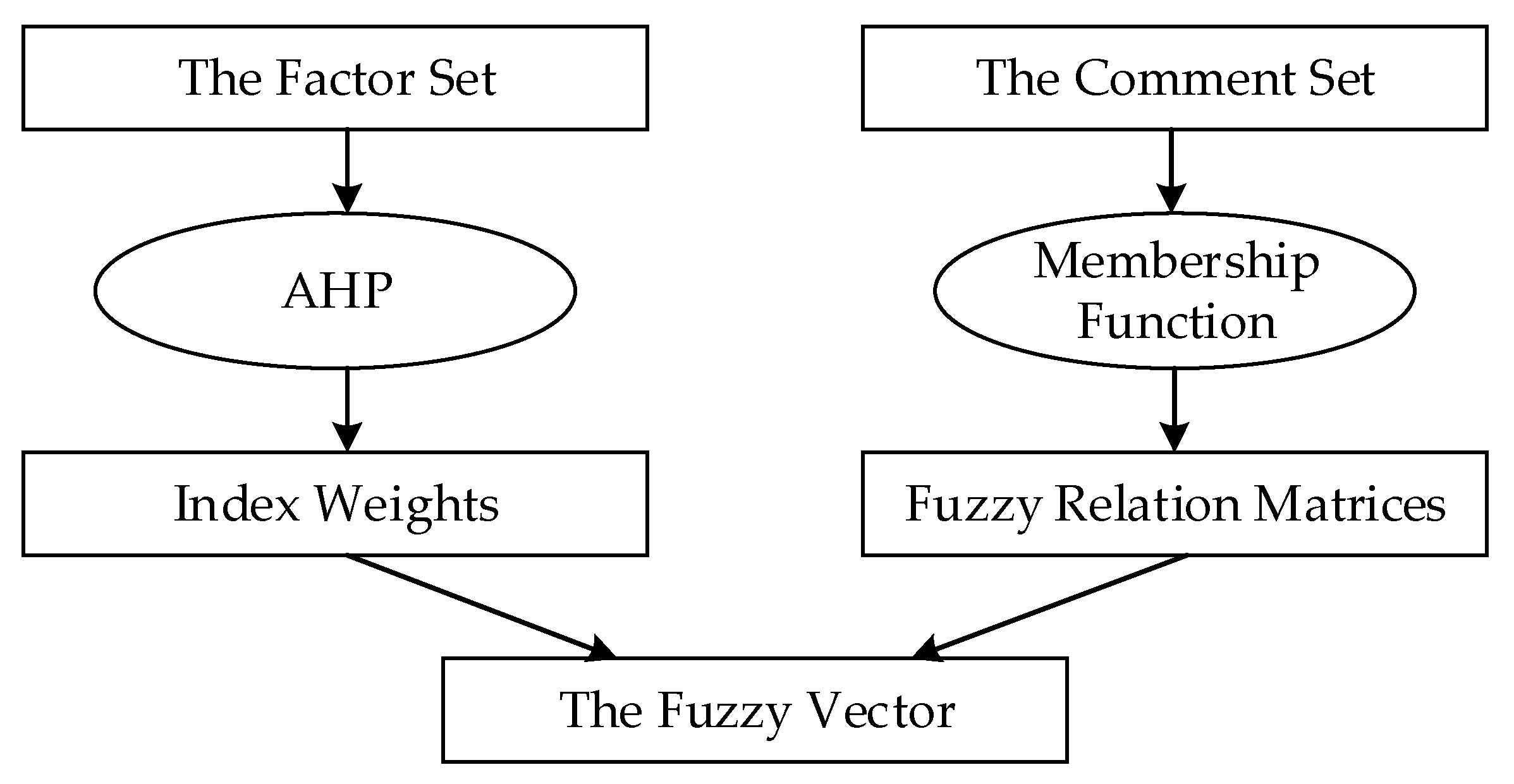
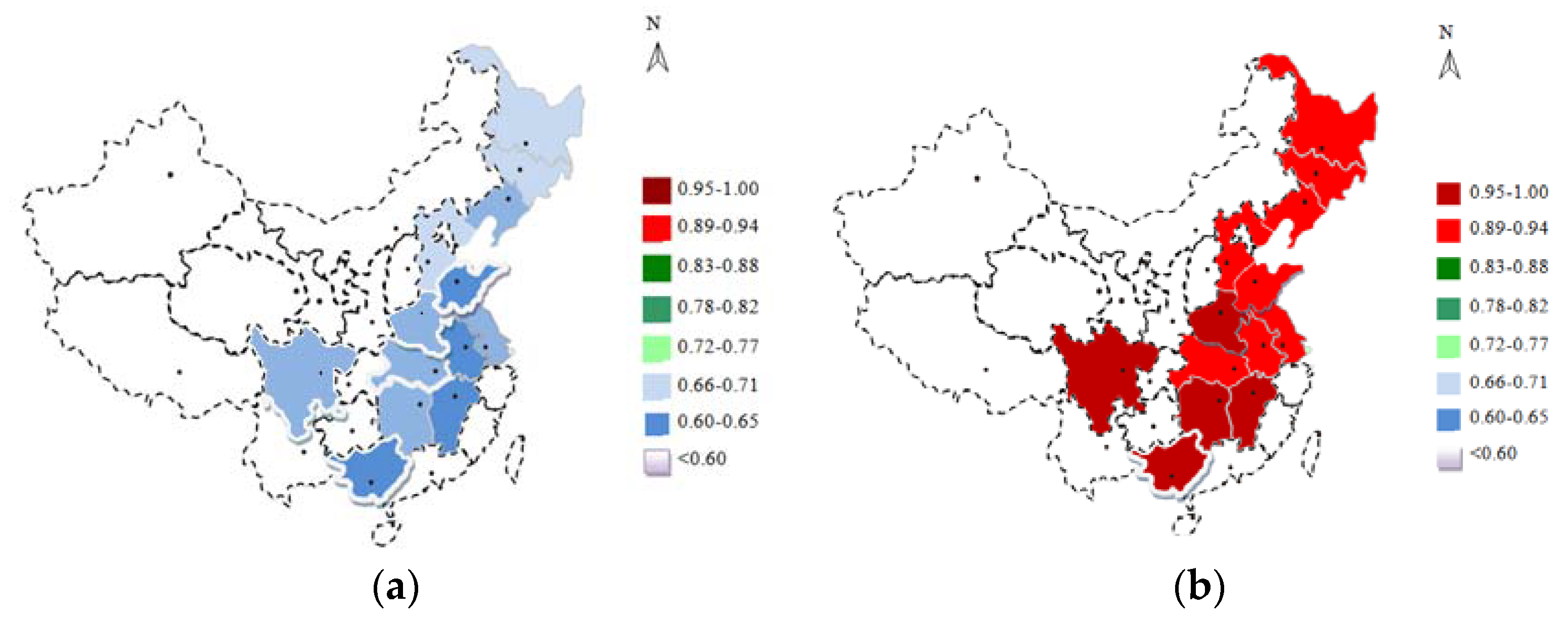
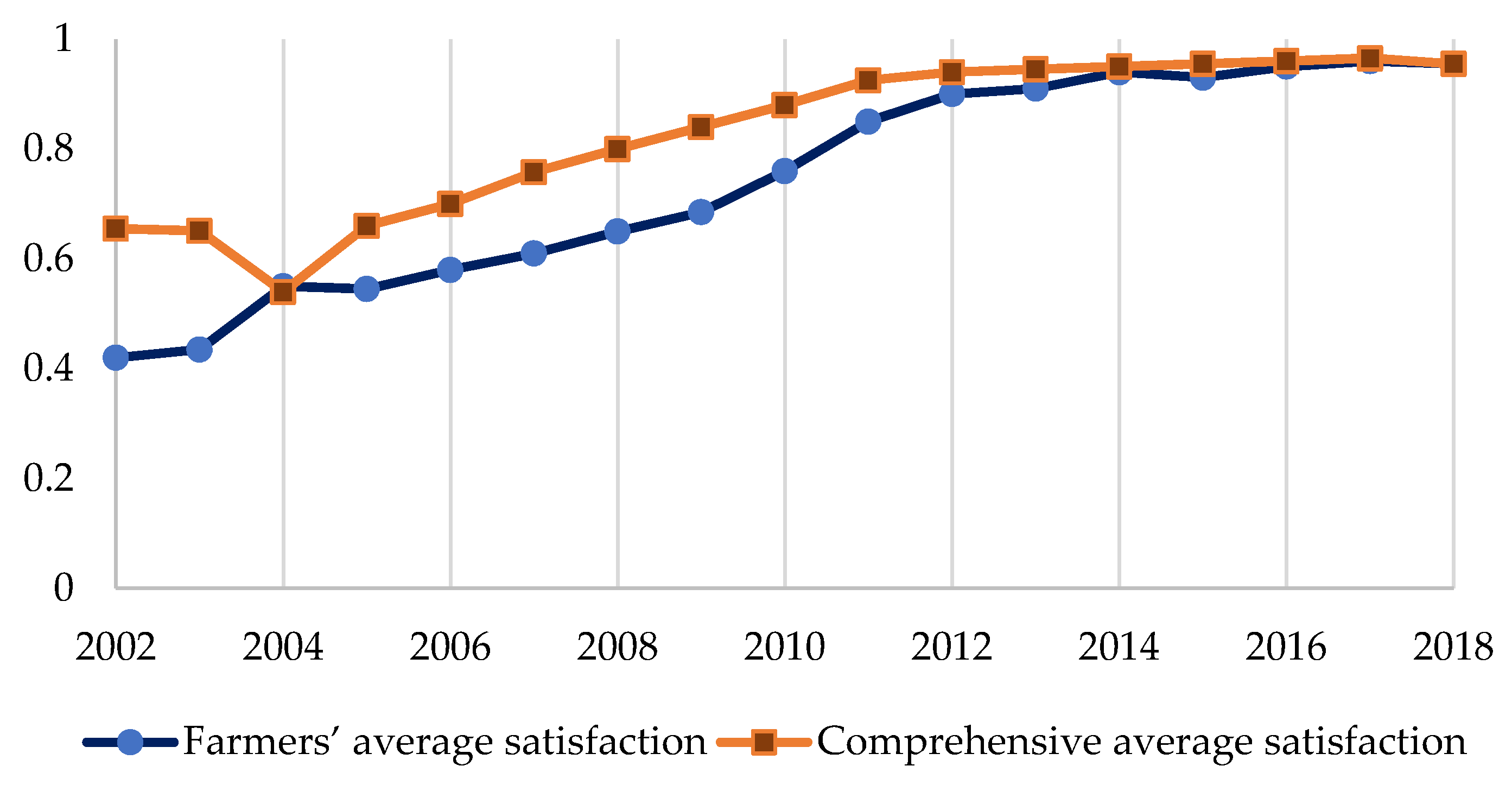
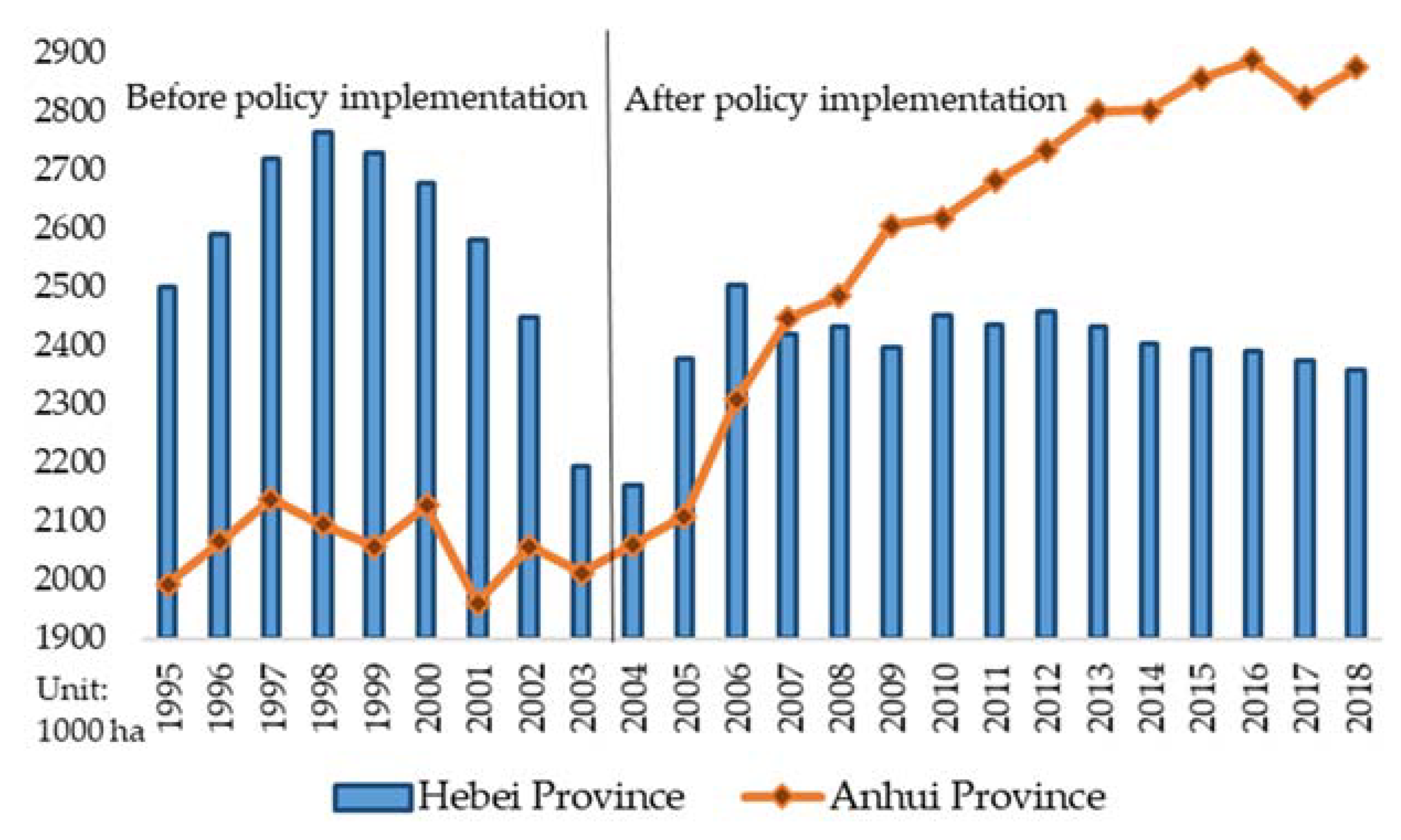
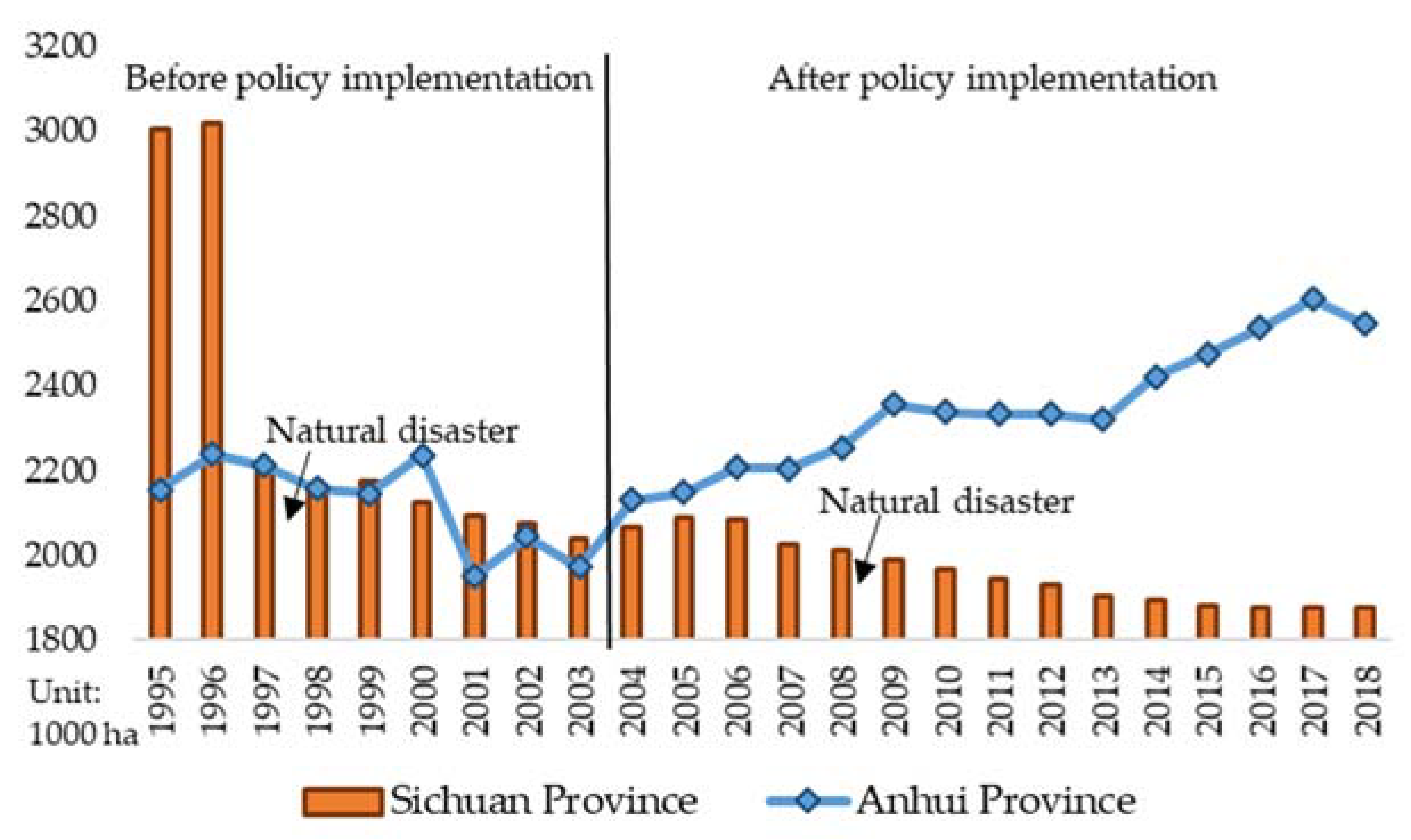
| Variety | 2004 | 2005 | 2006 | 2007 | 2008 | 2009 | 2010 | 2011 |
| Wheat | — | — | 0.72 | 0.72 | 0.77 | 0.87 | 0.9 | 0.95 |
| Early indica rice | 0.7 | 0.7 | 0.7 | 0.7 | 0.77 | 0.9 | 0.93 | 1.02 |
| Middle and late indica rice | 0.72 | 0.72 | 0.72 | 0.72 | 0.79 | 0.92 | 0.97 | 1.07 |
| Japonica rice | 0.75 | 0.75 | 0.75 | 0.75 | 0.82 | 0.95 | 1.05 | 1.28 |
| Variety | 2012 | 2013 | 2014 | 2015 | 2016 | 2017 | 2018 | 2019 |
| Wheat | 1.02 | 1.12 | 1.18 | 1.18 | 1.18 | 1.18 | 1.15 | 1.12 |
| Early indica rice | 1.2 | 1.32 | 1.35 | 1.35 | 1.33 | 1.3 | 1.2 | 1.2 |
| Middle and late indica rice | 1.25 | 1.35 | 1.38 | 1.38 | 1.38 | 1.36 | 1.26 | 1.26 |
| Japonica rice | 1.4 | 1.5 | 1.55 | 1.55 | 1.55 | 1.5 | 1.3 | 1.3 |
| Group | Evaluation Index |
|---|---|
| The Government (B1) | Satisfaction of cultivated area (C11) Satisfaction of grain reserves (C12) Satisfaction of acquisition cost (C13) |
| Farmers (B2) | Satisfaction of planting income (C21) Satisfaction of educational level (C22) Satisfaction of urban-rural income gap (C23) |
| Grain enterprises (B3) | Satisfaction of acquisition income (C31) Satisfaction of business risk (C32) |
| Consumers (B4) | Satisfaction of grain price (C41) Satisfaction of grain supply (C42) |
| Definition | |
|---|---|
| 1 | Equal importance between and |
| 3 | Moderate importance of over |
| 5 | Essential or strong importance of over |
| 7 | Demonstrated importance of over |
| 9 | Extreme importance of over |
| 2,4,6,8 | Intermediate values between two adjacent judgments |
| n | 1 | 2 | 3 | 4 | 5 | 6 | 7 | 8 | 9 | 10 | 11 |
|---|---|---|---|---|---|---|---|---|---|---|---|
| RI | 0 | 0 | 0.58 | 1.12 | 1.24 | 1.32 | 1.41 | 1.45 | 1.45 | 1.49 | 1.51 |
| Target Layer | Criterion Layer | Scheme Layer |
|---|---|---|
| Satisfaction of MPP policy (A) | The Government (B1) | Satisfaction of cultivated area (C11) |
| Satisfaction of grain reserves (C12) | ||
| Satisfaction of acquisition cost (C13) | ||
| Farmers (B2) | Satisfaction of planting income (C21) | |
| Satisfaction of educational level (C22) | ||
| Satisfaction of urban-rural income gap (C23) | ||
| Grain enterprises (B3) | Satisfaction of acquisition income (C31) | |
| Satisfaction of business risk (C32) | ||
| Consumers (B4) | Satisfaction of grain price (C41) | |
| Satisfaction of grain supply (C42) |
| Matrices | A | B1 | B2 | B2 | B4 |
|---|---|---|---|---|---|
| Consistency ratio | 0.0433 | 0.0332 | 0.0559 | 0 | 0 |
| Criterion Layer | B1 | B2 | B3 | B4 | ||||||
|---|---|---|---|---|---|---|---|---|---|---|
| Weight | 0.57 | 0.26 | 0.11 | 0.06 | ||||||
| Scheme layer | C11 | C12 | C13 | C21 | C22 | C23 | C31 | C32 | C41 | C42 |
| Weight | 0.36 | 0.15 | 0.06 | 0.19 | 0.05 | 0.02 | 0.08 | 0.03 | 0.05 | 0.01 |
| Government | Farmers | Enterprises | Consumers | Average | ||||||
|---|---|---|---|---|---|---|---|---|---|---|
| Year | 2003 | 2018 | 2003 | 2018 | 2003 | 2018 | 2003 | 2018 | 2003 | 2018 |
| Hebei | 0.76 | 0.87 | 0.66 | 0.94 | 0.72 | 0.89 | 0.77 | 0.9 | 0.723 | 0.9 |
| Jiangsu | 0.75 | 0.8 | 0.66 | 0.9 | 0.79 | 0.95 | 0.78 | 0.99 | 0.745 | 0.91 |
| Anhui | 0.78 | 0.89 | 0.6 | 0.91 | 0.72 | 0.85 | 0.77 | 0.87 | 0.718 | 0.88 |
| Shandong | 0.79 | 0.9 | 0.65 | 0.9 | 0.72 | 0.84 | 0.76 | 0.88 | 0.73 | 0.88 |
| Henan | 0.8 | 0.91 | 0.67 | 0.95 | 0.76 | 0.86 | 0.74 | 0.85 | 0.743 | 0.893 |
| Hubei | 0.79 | 0.9 | 0.7 | 0.94 | 0.72 | 0.88 | 0.76 | 0.84 | 0.743 | 0.89 |
| Jiangxi | 0.8 | 0.91 | 0.64 | 0.95 | 0.73 | 0.83 | 0.71 | 0.85 | 0.738 | 0.885 |
| Hunan | 0.78 | 0.93 | 0.67 | 0.95 | 0.71 | 0.84 | 0.73 | 0.84 | 0.723 | 0.89 |
| Guangxi | 0.79 | 0.89 | 0.64 | 0.95 | 0.7 | 0.87 | 0.76 | 0.86 | 0.733 | 0.892 |
| Liaoning | 0.77 | 0.9 | 0.7 | 0.94 | 0.7 | 0.91 | 0.77 | 0.87 | 0.735 | 0.905 |
| Jilin | 0.76 | 0.91 | 0.69 | 0.93 | 0.76 | 0.9 | 0.7 | 0.9 | 0.728 | 0.91 |
| Heilongjiang | 0.75 | 0.92 | 0.7 | 0.94 | 0.72 | 0.89 | 0.75 | 0.86 | 0.73 | 0.903 |
| Sichuan | 0.78 | 0.9 | 0.71 | 0.96 | 0.75 | 0.87 | 0.74 | 0.86 | 0.745 | 0.898 |
| Average | 0.777 | 0.895 | 0.675 | 0.935 | 0.731 | 0.875 | 0.749 | 0.875 | 0.733 | 0.895 |
© 2020 by the authors. Licensee MDPI, Basel, Switzerland. This article is an open access article distributed under the terms and conditions of the Creative Commons Attribution (CC BY) license (http://creativecommons.org/licenses/by/4.0/).
Share and Cite
Liu, Z.; Liang, H.; Pu, D.; Xie, F.; Zhang, E.; Zhou, Q. How Does the Control of Grain Purchase Price Affect the Sustainability of the National Grain Industry? One Empirical Study from China. Sustainability 2020, 12, 2102. https://doi.org/10.3390/su12052102
Liu Z, Liang H, Pu D, Xie F, Zhang E, Zhou Q. How Does the Control of Grain Purchase Price Affect the Sustainability of the National Grain Industry? One Empirical Study from China. Sustainability. 2020; 12(5):2102. https://doi.org/10.3390/su12052102
Chicago/Turabian StyleLiu, Zhiqiang, Hejun Liang, Dongping Pu, Fei Xie, E Zhang, and Qi Zhou. 2020. "How Does the Control of Grain Purchase Price Affect the Sustainability of the National Grain Industry? One Empirical Study from China" Sustainability 12, no. 5: 2102. https://doi.org/10.3390/su12052102
APA StyleLiu, Z., Liang, H., Pu, D., Xie, F., Zhang, E., & Zhou, Q. (2020). How Does the Control of Grain Purchase Price Affect the Sustainability of the National Grain Industry? One Empirical Study from China. Sustainability, 12(5), 2102. https://doi.org/10.3390/su12052102





